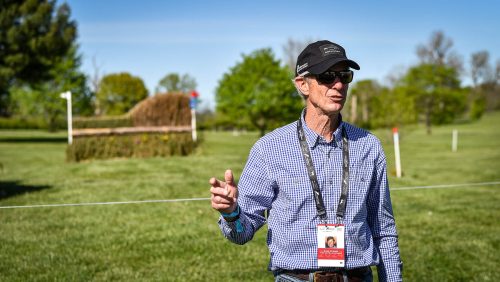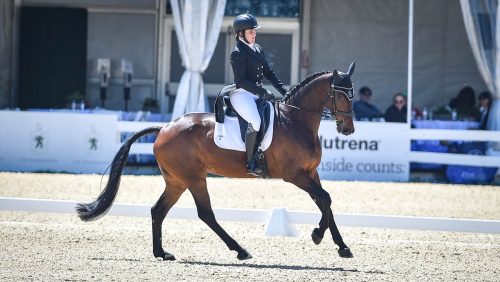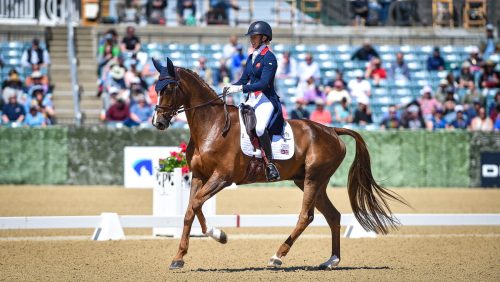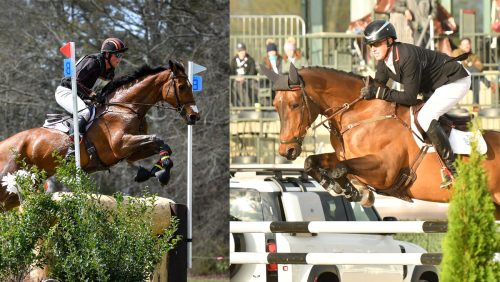The thing about sitting on a really talented horse is that you begin to think that you are a really talented rider. And while sometimes that is the case, I think more often than not, riders are weakest where their horses are strongest. That is the nature of partnership, after all.
When I was bringing up my off-the-track Trance, a look at our results would have led to two conclusions about my riding:
- I am terrible at dressage
- I am really strong in the show jumping
Trance moves a bit like a short-strided cow, so dressage was never his strength physically or mentally. You put a jump in front of that horse, though, and he would clear it from any spot on any canter.
For the decade that I competed Trance, I slaved over dressage. I invested thousands in lessons, went to dressage shows on the side, and studied videos almost daily of our rides. I knew that if Trance could improve his dressage score, he could finish on it. The last two years we competed at intermediate, he never scored above the 30s, and for Trance, that was damn miraculous.
Over that same 10-year career I only had a handful of rails in show jumping. When I say the horse could jump from anywhere, I mean it. At his two-star I put two strides in a one-stride combination, and he left the rails up.
While I became a really confident show jumper riding him, I don’t think I became a very good one. When every mistake a rider makes is easily covered and forgiven, we make more mistakes as riders. And worse: I thought my riding contributed to the clean rounds, when in fact the rounds were clean in spite of my riding.
Flash forward to my current mount, Khaleesi (Lizzie). I got her off the track 2 1/2 years ago, and as of this past weekend she has been eventing for two years.
A look at my results with Lizzie would lead to two conclusions:
ADVERTISEMENT
- I am really strong in dressage
- I am terrible in the show jumping
Lizzie was the hardest horse I have ever ridden on the flat when I bought her, as her connection in the bridle was almost violent. She absolutely hated the bit. However, after a decade working to improve Trance’s weak phase, I felt really confident in my ability to handle problems in dressage. With the skills I got from Trance, I was able to produce Lizzie on the flat quite comfortably. While Trance was never in the top after dressage, he is the reason I have the skills to put Lizzie there.
The surprise demon for me was how weak my show jumping was after such a great career on Trance. Lizzie is not the best show jumper, so she actually needs my help in this phase. Pretty quickly, however, I realized I didn’t have a lot of help to offer. My old technique of just kind of counting my canter and aiming at fences and magically having clear rounds didn’t work with her.
I couldn’t go with my normal team (Morningside) to Florida this year because work is too crazy, so I ended up putting Lizzie in Aiken, S.C., and commuting myself each week. This winter I specifically wanted to work on my show jumping, as my goal for this year is to see more consistency in this phase. Lizzie has spent a year at preliminary, but I really want consistent clear or one-rail rounds out of her before we consider moving up. I know she can do it—I just have to ride better.
My work with her this winter has primarily been on refining my aids and keeping them consistent the last three strides so she can focus on the jump. When jumping her with Doug Payne, I get lectured on my variance in leg pressure at the base of the fence. If I get her there on a good canter, my leg pressure must stay the same. If it lessens, she drops behind me. If it increases, she is distracted. Either of those and we have the rail.
In my lesson with Jan Byyny this week she worked on my hands, and the need for an automatic release with completely consistent pressure over the fence. One pound too little pressure in the last couple strides, and she tips over in her balance. One pound too much pressure in the last stride, and she hollows against the bit. Either of those and we have the rail.
Granted, not every horse is as tough to show jump as Lizzie. As Doug says, I have to walk a really fine line with my riding on her, and she requires a change in approach often fence to fence on course. She can vacillate between overly bold and hot to one fence, then stalling and hesitant to the next.
My time with Lizzie down here working on my show jumping has been wonderful. The toolbox I have gotten this past year from Skyeler Voss and the things I am adding now are giving me skills I can bring to any horse for the rest of my life.
I think a lot of riders hate working on something they are “bad” at, or get frustrated easily and want a different horse. I look at Lizzie and think that she is making me such a better rider. I have had more rails with her in one year than I had with Trance in a decade, but she is the one teaching me how to actually show jump a course.
ADVERTISEMENT
Lizzie and I went out last weekend to the jumper show at Highfields and signed up for our biggest course yet: the 1.10-meter. With her aimed at a one-star in a month, we are pressing our comfort with height and skill. The jumper courses are more square, more maxed out, and more difficult than the ones at events for the same height, so where better to practice?
We warmed up with the 1.05-meter class (representative of our current level in eventing) and had just one rail when she barely tapped the front rail of a triple bar, of all things.
Doug told me to go back in and do the same ride in the larger class. I thought about going home on the good round, because the hardest part of riding well is riding well consistently, and I just didn’t know that I could recreate another whole course of perfectly balanced take-offs. I worried that my aids would become inconsistent, or I would have a bad round and have to go home with that. But then Lizzie stomped around and charged a bit at the gate, and I thought, well, we aren’t going to get better by thinking about it.
So we went in and I actually did the exact same ride, to every fence, consistently. When I went through the finish flags and realized we were clean, I was ecstatic! The steward said he had never seen someone so excited to jump clear. I told him that, for me, on this horse, that is pretty much winning a gold medal. We even got third place and some money!
And that’s the thing about talent and horses, it is easy to take the accolades as a rider and leave the complaints at the horse’s hooves. Records don’t tell a very good story and, often, where we think we are strong we are just too easily forgiven.
So here’s to refining our skills, and to the horses that require us to do so. Here’s to helping the horses out half as much as they help us.
One of the Chronicle’s bloggers, Kristin Carpenter juggles the management of her own company, Linder Educational Coaching, organizing the Area II Young Rider Advancement Program out of Morningside Training Farm in The Plains, Va., and eventing at the FEI levels. She grew up in Louisiana and bought “Trance,” a green off-the-track Thoroughbred, as a teenager. Together, they ended up competing at the North American Young Riders Championships and the Bromont CCI**. She’s now bringing another OTTB, Lizzie, up through the ranks.















